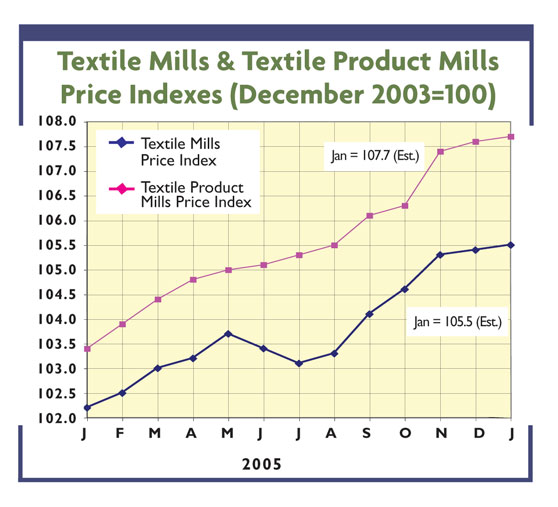T
he year 2005 was one of the most dynamic years ever for the US textile and fiber
industries and spinners certainly had a front-row seat. The year kicked off with the January 1
expiration of quotas on textile and apparel products.
In March, trade figures for January become available. Imports from China in major apparel
products doubled when compared to January 2004. Some products, such as cotton trousers, saw import
increases of as much as 1,000 percent. China took a 35-percent share of the US import market for
textiles, and a 22 percent share for apparel. The total Chinese share of the US import market was
29 percent – the highest share of any single country in history.
“The quota phaseout was a landmark, watershed event,” said Gary A. Raines III, manager, fiber
economics, Cotton Incorporated, Cary, N.C. “It completely changed the playing field and was a shift
in paradigm. We began to see a dramatic increase in textile shipments coming into the United States
from China. Basically what everyone was afraid would happen ended up happening. Not only did the
Chinese volume come in much faster than expected, but we also saw that the cost per unit (kilogram
or square meter equivalent) was dramatically lower on the Chinese product in the absence of
quotas.”
In July, the House of Representatives passed the Dominican Republic-Central American Free
Trade Agreement (DR-CAFTA). Two of the industry’s major trade groups – The National Council of
Textile Organizations (NCTO) and The American Manufacturing Trade Action Coalition (AMTAC) – took
opposing views on the trade measure. NCTO strongly backed DR-CAFTA and said, “The passage of
DR-CAFTA means that the jobs of US textile workers are more secure today than they were yesterday.”
AMTAC described the agreement as a “job killer” and voiced concerns it could cost an
estimated $1 billion in US textile and apparel exports. Most spinners sided with NCTO, seeing
DR-CAFTA as essential to the industry’s future.
“DR-CAFTA was really a matter of saving the industry,” said one spinner just after the
agreement’s passage. “Critics said we would lose jobs, and I don’t disagree. But I think it was a
matter of losing jobs or losing the industry. Some of the more labor-intensive work, which has been
going out of the United States for many years, will continue to move out. But there will be a base
left that might not have been possible without DR-CAFTA.”
“We view DR-CAFTA as necessary legislation to enable continued opportunity for the Central
American apparel industry,” said one specialty ring spinner. “We must have a healthy apparel
industry in Central America.”
In September, Hurricanes Katrina and Rita hit the gulf coast. Oil and man-made fiber prices
spiked. The fallout from these natural disasters also set some spinners scrambling to find
transportation to get their yarn to customers domestically and in Central America.
In November, the United States and China reached a comprehensive 3-year bilateral textile
trade agreement, which cut China’s market access in 14 core apparel categories during 2006 by 2.5
percent, compared to what the US industry could have expected under a safeguard reapplication
process. In addition, the agreement placed 20 new textile and apparel categories under three-year
quota control including combed cotton yarn, knit fabric, swimwear, sweaters, fiberglass fabrics,
ramie trousers, industrial fabrics and textile blinds.
2006: Eyes On China
As mill executives survey the issues confronting them in 2006 — including implementation of
DR-CAFTA, continued industry consolidation, man-made fiber prices, retail trends and future trade
agreements — China will continue to demand the lion’s share of their attention.
“China is not the only story, but it is a big story that only continues to get bigger,” said
Raines. “Estimates for Chinese cotton mill use continue to grow and are now roughly 43 million
bales for this marketing year. This has more than doubled in the last seven or eight years. And I
believe that the 43 million-bale estimate is too low.”
According United States Department of Agriculture estimates, China will import 16.5 million
bales of cotton this year, compared to 8.8 million bales last year. About half of China’s cotton
imports will come from the United States, according to Raines. In other words, roughly one in three
bales grown in the Unites States this year will be used in a Chinese mill. China also has become
the world’s largest importer of cotton yarns.
“This year for the first time since Reconstruction [after the Civil War], a foreign country
will use more US cotton than the United States does,” Raines said.
January/February 2006





